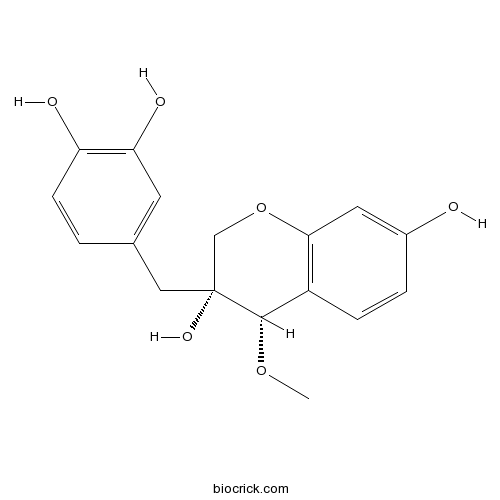4-O-MethylsappanolCAS# 104778-16-7 |

- 4-O-Methylepisappanol
Catalog No.:BCN3674
CAS No.:112529-37-0
Quality Control & MSDS
3D structure
Package In Stock
Number of papers citing our products

| Cas No. | 104778-16-7 | SDF | Download SDF |
| PubChem ID | 13888973 | Appearance | Powder |
| Formula | C17H18O6 | M.Wt | 318.3 |
| Type of Compound | Flavonoids | Storage | Desiccate at -20°C |
| Solubility | Soluble in Chloroform,Dichloromethane,Ethyl Acetate,DMSO,Acetone,etc. | ||
| Chemical Name | (3R,4S)-3-[(3,4-dihydroxyphenyl)methyl]-4-methoxy-2,4-dihydrochromene-3,7-diol | ||
| SMILES | COC1C2=C(C=C(C=C2)O)OCC1(CC3=CC(=C(C=C3)O)O)O | ||
| Standard InChIKey | HHDPKXQKOWHDNA-DLBZAZTESA-N | ||
| Standard InChI | InChI=1S/C17H18O6/c1-22-16-12-4-3-11(18)7-15(12)23-9-17(16,21)8-10-2-5-13(19)14(20)6-10/h2-7,16,18-21H,8-9H2,1H3/t16-,17+/m0/s1 | ||
| General tips | For obtaining a higher solubility , please warm the tube at 37 ℃ and shake it in the ultrasonic bath for a while.Stock solution can be stored below -20℃ for several months. We recommend that you prepare and use the solution on the same day. However, if the test schedule requires, the stock solutions can be prepared in advance, and the stock solution must be sealed and stored below -20℃. In general, the stock solution can be kept for several months. Before use, we recommend that you leave the vial at room temperature for at least an hour before opening it. |
||
| About Packaging | 1. The packaging of the product may be reversed during transportation, cause the high purity compounds to adhere to the neck or cap of the vial.Take the vail out of its packaging and shake gently until the compounds fall to the bottom of the vial. 2. For liquid products, please centrifuge at 500xg to gather the liquid to the bottom of the vial. 3. Try to avoid loss or contamination during the experiment. |
||
| Shipping Condition | Packaging according to customer requirements(5mg, 10mg, 20mg and more). Ship via FedEx, DHL, UPS, EMS or other couriers with RT, or blue ice upon request. | ||
| Description | 1. 4-O-Methylsappanol shows activity against this fungus against Beauveria bassiana. |
| Targets | Antifection |

4-O-Methylsappanol Dilution Calculator

4-O-Methylsappanol Molarity Calculator
| 1 mg | 5 mg | 10 mg | 20 mg | 25 mg | |
| 1 mM | 3.1417 mL | 15.7085 mL | 31.4169 mL | 62.8338 mL | 78.5423 mL |
| 5 mM | 0.6283 mL | 3.1417 mL | 6.2834 mL | 12.5668 mL | 15.7085 mL |
| 10 mM | 0.3142 mL | 1.5708 mL | 3.1417 mL | 6.2834 mL | 7.8542 mL |
| 50 mM | 0.0628 mL | 0.3142 mL | 0.6283 mL | 1.2567 mL | 1.5708 mL |
| 100 mM | 0.0314 mL | 0.1571 mL | 0.3142 mL | 0.6283 mL | 0.7854 mL |
| * Note: If you are in the process of experiment, it's necessary to make the dilution ratios of the samples. The dilution data above is only for reference. Normally, it's can get a better solubility within lower of Concentrations. | |||||

Calcutta University

University of Minnesota

University of Maryland School of Medicine

University of Illinois at Chicago

The Ohio State University

University of Zurich

Harvard University

Colorado State University

Auburn University

Yale University

Worcester Polytechnic Institute

Washington State University

Stanford University

University of Leipzig

Universidade da Beira Interior

The Institute of Cancer Research

Heidelberg University

University of Amsterdam

University of Auckland

TsingHua University

The University of Michigan

Miami University

DRURY University

Jilin University

Fudan University

Wuhan University

Sun Yat-sen University

Universite de Paris

Deemed University

Auckland University

The University of Tokyo

Korea University
- Sappanone B
Catalog No.:BCN7942
CAS No.:104778-15-6
- Plantamajoside
Catalog No.:BCN6279
CAS No.:104777-68-6
- 3alpha-Akebonoic acid
Catalog No.:BCN5862
CAS No.:104777-61-9
- Entacapone sodium salt
Catalog No.:BCC4107
CAS No.:1047659-02-8
- Afuresertib
Catalog No.:BCC5502
CAS No.:1047644-62-1
- GSK2141795 hydrochloride
Catalog No.:BCC5295
CAS No.:1047635-80-2
- GSK2141795
Catalog No.:BCC5294
CAS No.:1047634-65-0
- Strontium chloride
Catalog No.:BCC7973
CAS No.:10476-85-4
- Ganoderic acid S
Catalog No.:BCN5861
CAS No.:104759-35-5
- 4E-Deacetylchromolaenide 4'-O-acetate
Catalog No.:BCN7263
CAS No.:104736-09-6
- Mayteine
Catalog No.:BCN3098
CAS No.:104736-05-2
- 6-O-α-Maltosyl-β-cyclodextrin
Catalog No.:BCC8075
CAS No.:104723-60-6
- MRS 2768 tetrasodium salt
Catalog No.:BCC7800
CAS No.:1047980-83-5
- Masitinib mesylate
Catalog No.:BCC1729
CAS No.:1048007-93-7
- COR 170
Catalog No.:BCC6282
CAS No.:1048039-15-1
- Alpha-Terpineol
Catalog No.:BCN8136
CAS No.:10482-56-1
- Germanicol acetate
Catalog No.:BCN7264
CAS No.:10483-91-7
- UPF 1069
Catalog No.:BCC2213
CAS No.:1048371-03-4
- NF 157
Catalog No.:BCC7367
CAS No.:104869-26-3
- NF 023
Catalog No.:BCC6985
CAS No.:104869-31-0
- (+)-Isopulegol
Catalog No.:BCN4975
CAS No.:104870-56-6
- dl-Aloesol
Catalog No.:BCN7265
CAS No.:104871-04-7
- Borapetoside B
Catalog No.:BCN6593
CAS No.:104901-05-5
- Tranilast Sodium
Catalog No.:BCC4091
CAS No.:104931-56-8
Cytoprotective constituents of the heartwood of Caesalpinia sappan on glutamate-induced oxidative damage in HT22 cells.[Pubmed:19420770]
Biol Pharm Bull. 2009 May;32(5):945-9.
The bioassay-guided fractionation of a MeOH extract of the heartwood of Caesalpinia sappan L. provided two neuroprotective compounds, sappanchalcone (2) and 4-O-methylepisappanol (3), together with a methoxychalcone, isoliquiritigenin 2'-methyl ether (1), and three aromatic compounds, 4-O-Methylsappanol (4), caesalpine J (5), pluchoic acid (6). At concentrations of 20-40 microM, compound 2 showed significant cytoprotective effects against glutamate-induced oxidative stress through the induction of heme oxygenase (HO)-1 in HT22-immortalized hippocampal cells. Compound 3 also showed moderate neuroprotective effect at 40 microM, but compounds 1, 4-6 did not show any protective effects against glutamate-induced cytotoxicity in HT22 cells.
Inhibitory activity of homoisoflavonoids from Caesalpinia sappan against Beauveria bassiana.[Pubmed:12946725]
Fitoterapia. 2003 Sep;74(6):600-2.
Four homoisoflavonoids, 4-O-Methylsappanol (1), protosappanin A (2), brazilin (3) and caeasalpin J (4), isolated from Caesalpinia sappan, were tested for inhibitory activity against Beauveria bassiana. Compound 1 showed activity against this fungus.


